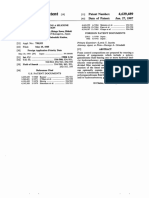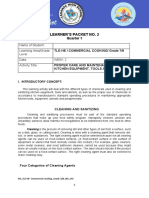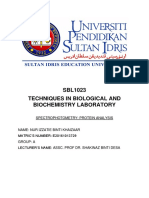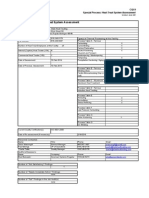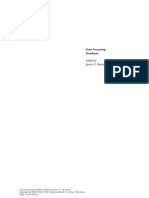US4790877
US4790877
Uploaded by
indoarmy1450 ratings0% found this document useful (0 votes)
23 views4 pagesTmr clear
Copyright
© © All Rights Reserved
Available Formats
PDF, TXT or read online from Scribd
Share this document
Did you find this document useful?
Is this content inappropriate?
Report this DocumentTmr clear
Copyright:
© All Rights Reserved
Available Formats
Download as PDF, TXT or read online from Scribd
Download as pdf or txt
0 ratings0% found this document useful (0 votes)
23 views4 pagesUS4790877
US4790877
Uploaded by
indoarmy145Tmr clear
Copyright:
© All Rights Reserved
Available Formats
Download as PDF, TXT or read online from Scribd
Download as pdf or txt
You are on page 1of 4
United States Patent (19) 11 Patent Number: 4,790,877
Vadasz. 45 Date of Patent: Dec. 13, 1988
54) SILICONE EMULSION POLISHES AND 56 References Cited
THEIR FORMULATION U.S. PATENT DOCUMENTS
2,856,297 10/1958 Green ...................................... 106/3
75 Inventor: Jeffery L. Vadasz, Dunedin, Fla. 2,955,047 10/1960 Terry ...................................... O6/3
3,460,981 8/1969 Keil ....................................... 106/3
3,576,779 4/1971 Holdstock ............................. 106/11
(73) Assignee: Rojef Distributors, Inc., St. 4,013,475 3/1977 Liebowitz ............................. 106/10
Petersburg, Fla. 4,614,612 9/1986 Reilly et al. ......................... 252/541
Primary Examiner-Theodore Morris
21 Appl. No.: 83,972 Attorney, Agent, or Firm-Charles A. McClure
57 ABSTRACT
22) Filed: Aug. 11, 1987 Wax-free silicone emulsion compositions for polishing
vehicles inside and out. One principal and preferably a
couple secondary polysiloxanes in emulsion form re
51 Int. Cl* ........................... C09D 3/02; B32B 9/06 ceive a mixture of lower alkanol and citrus juice in a
52) U.S. Cl. ........................................... 106/3; 106/4; preferred formulation of polish composition, which can
428/447; 428/450 be wiped on to dry streak-free without dry wiping.
58) Field of Search ................. 106/3, 4, 11; 428/447,
428/450 34 Claims, No Drawings
4,790,877
1 2
polishing composition of this invention consists mainly
SLICONE EMULSION POLISHES AND THEIR of polydimethylsiloxane, in the form of an aqueous
FORMULATION emulsion, at a concentration of, say, 60%. An example
of such a composition is readily available from GE (i.e.,
TECHNICAL FIELD General Electric Company) as SM 2163 Silicone Emul
This invention relates to silicone emulsion composi sion, having a maximum viscosity of 2500 cps at 25 C.
tions and to their formulation, especially wax-free pol and a density of 8.25 pounds per gallon (about 1.0 gram
ishes for vehicles. per cc). Such silicone polymer-apart from the water in
BACKGROUND OF THE INVENTION 10
the emulsion--is useful according to this invention in a
concentration of from as little as several percent to as
Anyone who has ever polished the exterior of an much as about a half dozen percent of the total final
automobile knows how much physical effort and appli product, which is itself about 70 to 80 percent water
cation time are required, notwithstanding an advertised overall.
ease of application or portraits of smiling users on the 15
Preferably also, in the interest of durability of the
polish label. Boats and airplanes are even worse, as they shine resulting from use of the polishing composition of
have more surface area and are harder to reach. this invention, one or more reactive silicones are in
First, the vehicle to be polished must be washed and cluded. An example of such a composition is an amine
dried. Then, not only does the polishing liquid, emul functional silicone polymer. Such polymer can be cured
sion, or paste have to be applied by hand onto the finish by cross-linking internally and/or with other polymers
of such vehicle to dry, but numerous streaks and swirls 20 via available reactive groups, such as alkoxy, carboxy,
of the dried excess must be removed by dry wiping over or hydroxy, especially when exposed to sun and air. A
essentially the entire surface already covered. particular example of a suitable amine-functional sili
The prior art features U.S. Pat. No. 4,600,436 to cone is GE's SM 2059, available at 20 cps and at a spe
Traver et al. (General Electric Co.) and others men cific gravity just slightly less than that of water, in the
tioned therein; van der Linde U.S. Pat. No. 4,398,953 25 form of an aqueous emulsion at, say, 35% concentra
(Borden, Inc.); Martin 3,960,575 (SWS Silicones Corp.); tion. Such polymer is optionally included in the polish
and Duncan 3,814,710 (ICI). ing composition of this invention to an extent of one or
Although otherwise represented by the purveyors of two tenths percent to one percent (taken water
polishing compositions, the durability of the resulting free)-or about 3 to 1 percent as starting emulsion.
gloss or shine seems to correlate fairly well with how 30 An additional silicone polymer, specifically reactive
much effort, not to say exertion, was required of the with an amine-functional silicone polymer, may be
applier of the polish during its application. An obvious added in like amount for enhancement of the durability
need exists for an easier and simpler alternative to the of the resulting shine. Suitable for such purpose is GE's
present method of keeping up the appearance of the
family car or other vehicle. It also would be helpful if an 35 SM 2079, which is available at 100-500 cps and the
identical polish could be used inside, as well as out. specific gravity of water in an aqueous emulsion of
60%.
STATEMENT OF THE INVENTION In formulation of the polishing composition of this
A primary objective of the present invention is to invention each silicone polymer used (preferably in
minimize the time and effort required to impart a high pre-emulsified form) is mixed into water, conveniently
gloss to the finish of practically any vehicle exterior containing up to several tenths of a percent of an emulsi
surface. fying agent before adding other components.
Another object of this invention is to shine the win Added to the resulting emulsion is enough lower
dows of the vehicle with the same polishing composi alkanol to be about 10 to 15 percent of the eventual
tion, inside and out. 45 total, and enough of a weakly acidic organic composi
A further object of the invention is to enable the tion to make up about several to a half dozen percent.
smooth interior surfaces of the vehicle to be shined The alcohol is preferably isopropanol, and the acid is
likewise, preferably concentrated lemon or other citrus juice. A
In general, the objects of this invention are accom preferred formulation approximates the mean of the
plished by means of a largely silicone emulsion polish 50 stated ranges of the respective ingredients. The func
ing composition. More particularly, such composition is tions of the respective silicones have been suggested
essentially wax-free. above and are generally understood. The alcohol acts in
Other objects of this invention, together with meth pertinent part as an evaporating and levelling agent,
ods and means for accomplishing the various objects, whereas the citric acid (and/or resultant ester) func
will be apparent from the following description of a 55 tions as a cleaning and anti-spotting or de-streaking
preferred embodiment of it, which is presented here by agent. Altogether the selected components coordinate
way of example rather than limitation. with one another in performing their respective func
DESCRIPTION OF THE INVENTION tions and integrating the desired end result.
As an example, water (about 75 parts) containing a
No wax or equivalent material is included in the pol couple hundredths part of conventional surfactant has
ishing composition of this invention. Exclusion of waxes mixed successively thereinto a half dozen parts of such
renders the polish easier to apply, free from streaks after polydimethylsiloxane emulsion and one part each of
application, and applied in only a single wet wiping emulsions of such amine-functional silicone polymer
without any dry wipe at all. and such mutually reactive silicone polymer. A sepa
The polishing composition of the present invention is 65 rately prepared mixture of a dozen parts of isopropanol
built about at least one silicone polymer to the extent of and several parts of lemon juice concentrate (itself sev
several to about ten percent. More particularly, except eral times juice strength) is added to the foregoing mix
for water, which is the preponderant ingredient, the ture. With thorough mixing, makeup water is added to
4,790,877
3. 4.
bring the total to 100 parts of an essentially homogene 11. Vehicle polish composition according to claim 10,
ous emulsion. wherein the alkanol comprises isopropanol in substan
Experience shows that the polishing composition of tial part.
the present invention can be wiped onto the finish of a 12. Vehicle polish composition according to claim 10,
vehicle and allowed to dry, whereupon it provides a wax-free.
high gloss without buffing. Washing or other preclean 13. Vehicle polish composition according to claim 12,
ing is not necessary except to remove accumulated in the form of an emulsion.
solids or sticky materials. The resulting shine is not 14. Vehicle polish composition, made up of water in
affected adversely by a rain shower and normally will major part, silicone aqueous emulsion to the extent of
last for weeks without further attention. It endows a 10 about 5 to 10 percent, water-miscible alkanol to the
polished vehicle with a desirably "wet" look, such as extent of about 10 to 20 percent, and citrus juice to the
usual on a showroom floor but not often later. extent of at least about several to a half dozen percent.
Moreover, the polishing composition of this inven 15. Vehicle polish composition according to claim 14,
tion is also suitable for use on the glass of windows and wherein the alkanol comprises isopropanol in at least
mirrors, as well. It is very effective in removing the 15 major part.
haze or cloudiness that often obscures the surface of 16. Formulating a polish composition, comprising the
glass. It also is effective on vinyl and similar plastic-cov steps of
ered surfaces such as often are found inside or outside adding about 5 to 10 parts of aqueous emulsion of at
automobiles and other vehicles. least one polymeric silicone to about 70 to 80 parts
Benefits of using the polishing composition of this 20 of water, and preferably including a fractional part
invention have been mentioned above and will become of a surfactant, as a first portion;
apparent to persons who undertake to use it. Compo adding at least about several parts of citrus juice to
nents and their formulation into such polish have been about 10 to 15 parts of lower alkanol, as a second
portion; and
prescribed, but variations in parts or steps may be em 25 mixing the first portion and the second portion to
ployed while retaining some or many of the benefits of gether.
this invention-which itself is defined in the following 17. Polish formulating method according to claim 16,
claims. wherein the water of the first portion is at a temperature
I claim: above ambient but nearer thereto than to the boiling
1. Wax-free buffing-free vehicle polish composition, 30 temperature of water.
comprising an aqueous mixture including 18. Polish formulating method according to claim 16,
at least one silcone polymer to the extent of several to wherein the components of the second portion are
about a half dozen percent, and mixed together at about ambient temperature.
citrus juice to the extent of at least several percent, 19. Polish formulating method according to claim 16,
and 35 wherein the second portion is mixed into the first por
water-miscible lower alkanol to the extent of ten to tion.
twenty percent. 20. Polish formulating method according to claim 16,
2. Vehicle polish composition according to claim 1, in wherein the predominant component of the polymeric
the form of an emulsion. silicone is polydimethylsiloxane.
3. Vehicle polish composition according to claim 1, 21. Polish formulating method according to claim 16,
wherein the silicone portion of the aqueous mixture wherein a minor part of the polymeric silicone material
comprises also in minor part a cross-linking amine-func comprises a cross-linking amine-functional silicone pol
tional silicone polymer. ymer.
4. Vehicle polish composition according to claim 3, 22. Formulating a polish composition having the
wherein the silicone portion of the aqueous mixture 45 characteristic of imparting a wet look to a motor vehi
comprises also in minor part a silicone polymer having cle to which applied and allowed to dry thereon with
alkoxy, carboxy, or hydroxy substituents reactive with out buffing, comprising the steps of mixing the follow
such amine-functional silicone polymer. ing into about 70 to 80 parts of water:
5. Vehicle polish composition according to claim 1, about 5 to 10 parts of polydimethylsiloxane emulsion,
wherein the lower alkanol comprises isopropanol in 50 about 10 to 20 parts of water-miscible alkanol, and
major part. at least about several parts of lemon juice or extract
6. Vehicle polish composition according to claim 1, thereof.
which comprises also in minor part an organic acid. 23. Polish formulating method according to claim 22,
7. Vehicle polish composition according to claim 6, 55 including mixing thereinto also about to 1 parts of at
which comprises lemon juice to the extent of at least least one aqueous emulsion of cross-linking silicone
several percent. polymer.
8. In a silicone-containing polish comopsition for 24. Polish formulating method method according to
vehicles, the improvement comprising at least several claim 23, wherein the polymer emulsions are mixed into
percent of lemon juice plus the characteristic of drying 60 the water first, and the other components are mixed
together and then added to the aqueous mixture.
to a wet look when wiped onto such a vehicle. 25. Polish formulating method according to claim 23,
9. Vehicle polish composition according to claim 8, wherein the resulting mixture is made up of the follow
wherein the lemon juice is present several times concen 1ng:
trated and equal to from about half of the silicone per about 10% to 20% of lower alkanol miscible with
centage to about the same as the silicone percentage. 65 water,
10. Vehicle polish composition according to claim 8, about 3% to 6% of silicone polymers measured wa
including a water-miscible alkanol to the extent of at ter-free,
least about twice the silicone percentage. about 3% to 4% of lemon juice concentrate, and
4,790,877
5 6
the rest water. reactive with such amine-functional silicone pol
26. Vehicle polish composition produced according ymer; and
to the formulating method of claim 16. water-miscible alkanol to the extent of about 10 to 20
27. Wax-free vehicle polish composition produced percent,
according to the formulating method of claim 22. 5 comprising isopropanol in major part; and
28. Wax-free vehicle polish composition produced several parts of citrus juice concentrate equivalent to
according to the formulating method of claim 25. about several times as much juice,
29. Method of shining a motor vehicle, comprising comprising lemon concentrate in major part.
wiping onto it in effective amount the polish composi 32. In formulating the vehicle-polishing composition
tion of claim 11. O of claim 31, the steps of
30. Method of shining a motor vehicle, comprising mixing such silicone polymers, pre-emulsified, into
wiping onto it in effective amount the polish composi about 75 parts of water containing a fractional part
tion formulated according to claim 22. of a surfactant, as a first mixture; and
31. Wax-free vehicle-polishing composition, made up mixing together, as a second mixture, such alkanol
of water in major part, and comprising, in emulsified
15 and such citrus concentrate; and then
form: adding the latter mixture to the former mixture; and
finally
polymeric silicones to at most about ten percent, adding enough water thereto to make up the total of
including 100 parts.
about a half dozen percent of polydimethylsilox 20 33. Method of shining a motor vehicle consisting
ane, and essentially of wiping onto it the vehicle-polishing com
from about 1 to 2 percent of cross-linking amine position of claim 31.
functional silicone polymer, and 34. Motor vehicle shined according to claim 33 to a
from about 1 to 2 percent of silicone polymer con wet look.
taining alkoxy, carboxy, or hydroxy substituents 25 : 3k se sk sk
30
35
45
50
55
60
65
You might also like
- Fire Sprinkler System Maintenance ChecklistDocument2 pagesFire Sprinkler System Maintenance ChecklistKevin Pagayaman100% (4)
- ES9-224 Lubricating Oil Rev WDocument13 pagesES9-224 Lubricating Oil Rev WIfran Sierra100% (1)
- Vehicle WashDocument12 pagesVehicle Washyilmaz_uuurNo ratings yet
- US4294740Document3 pagesUS4294740Safiullah KhanNo ratings yet
- US Patent For Polish Composition and Method of Use Patent (Patent # 6,193,791 Issued February 27, 2001) - Justia Patents SearchDocument37 pagesUS Patent For Polish Composition and Method of Use Patent (Patent # 6,193,791 Issued February 27, 2001) - Justia Patents SearchArcha UnniNo ratings yet
- United States Patent (19) : Jan. 29, 1985 45) Date of PatentDocument6 pagesUnited States Patent (19) : Jan. 29, 1985 45) Date of PatentSubramanian SudanthiramoorthyNo ratings yet
- United States Patent (19) : Barcelona, Jr. (45) Date of Patent: Nov. 17, 1992Document3 pagesUnited States Patent (19) : Barcelona, Jr. (45) Date of Patent: Nov. 17, 1992AMAN KEJAYANo ratings yet
- Us 4140641Document6 pagesUs 4140641huyền nguyễnNo ratings yet
- Patent Application Publication (10) Pub. No.: US 2009/0192234 A1Document26 pagesPatent Application Publication (10) Pub. No.: US 2009/0192234 A1Deva DrillTechNo ratings yet
- R - Us20070178239a1 PDFDocument8 pagesR - Us20070178239a1 PDFbutuh ganalNo ratings yet
- US3463735Document6 pagesUS3463735Sharda RamberanNo ratings yet
- United States Patent (19) : Malik Et Al. 45 Date of Patent: Jul. 7, 1987Document5 pagesUnited States Patent (19) : Malik Et Al. 45 Date of Patent: Jul. 7, 1987Mamoon ShahidNo ratings yet
- US3585051Document3 pagesUS3585051Archa UnniNo ratings yet
- Patent 3Document4 pagesPatent 3PankajNo ratings yet
- United States Patent 0: Patented Apr. 9, 1974 2Document5 pagesUnited States Patent 0: Patented Apr. 9, 1974 2lauraNo ratings yet
- US4145308Document9 pagesUS4145308A. Vafaie ManeshNo ratings yet
- Us 3917537Document3 pagesUs 3917537Pedro BortotNo ratings yet
- Demulsification of W-In-O Emulsions Exxon 2003 US6555009-GlgDocument8 pagesDemulsification of W-In-O Emulsions Exxon 2003 US6555009-GlgDavid Cruz ZamoraNo ratings yet
- US5208285Document10 pagesUS5208285Safiullah KhanNo ratings yet
- US5417876Document6 pagesUS5417876acit marocitNo ratings yet
- Lubricant Finish For TextilesDocument8 pagesLubricant Finish For Textilesali rezaeiNo ratings yet
- A Comparison of Hydrocarbon and Silicone Vacuum Greases: White PaperDocument6 pagesA Comparison of Hydrocarbon and Silicone Vacuum Greases: White PaperBhushan MalsheNo ratings yet
- Us 5037563Document6 pagesUs 5037563mgamal1080No ratings yet
- United States: (12) Patent Application Publication (10) Pub. No.: US 2013/0240408 A1Document4 pagesUnited States: (12) Patent Application Publication (10) Pub. No.: US 2013/0240408 A1Anil UpadhyaNo ratings yet
- Patent Application Publication (10) Pub. No.: US 2006/0230987 A1Document8 pagesPatent Application Publication (10) Pub. No.: US 2006/0230987 A1marcela walterosNo ratings yet
- Us 4639489Document7 pagesUs 4639489Pat22 22patNo ratings yet
- Us 4485037Document4 pagesUs 4485037Sana AllNo ratings yet
- Biodegradable Liquid Degreaser and Parts Cleaner CompositionDocument3 pagesBiodegradable Liquid Degreaser and Parts Cleaner Compositionali rezaeiNo ratings yet
- United States Patent: Nicks Et A1Document5 pagesUnited States Patent: Nicks Et A1Albert hikerNo ratings yet
- US4919839Document9 pagesUS4919839Mohamed AdelNo ratings yet
- United States Patent (19) (11) 4,024,096: 11 Claims, No DrawingsDocument4 pagesUnited States Patent (19) (11) 4,024,096: 11 Claims, No DrawingsFrichs condori monzonNo ratings yet
- Tyre Puncture SolutionDocument3 pagesTyre Puncture SolutionShreyansh ShahNo ratings yet
- US4686275Document4 pagesUS4686275Sayyed Abdul QayyumNo ratings yet
- United States Patent (19) : Pre-Mixed Catalyzed WinylacetateDocument6 pagesUnited States Patent (19) : Pre-Mixed Catalyzed WinylacetateSHRINIL DESAINo ratings yet
- Carbinol FunctionalDocument6 pagesCarbinol FunctionalJesus Chucho BruzualNo ratings yet
- US4147675Document8 pagesUS4147675Ilham Kiki ShahilaNo ratings yet
- US4097589 Nail PolishDocument4 pagesUS4097589 Nail PolishSafiullah KhanNo ratings yet
- United States Patent (19) 11) 4,361,843: An-Chung R. Lin, New Town, All of 12: Ag: EDocument6 pagesUnited States Patent (19) 11) 4,361,843: An-Chung R. Lin, New Town, All of 12: Ag: E216435964No ratings yet
- United States Patent (19) : (45) Date of Patent: Oct. 18, 1994Document5 pagesUnited States Patent (19) : (45) Date of Patent: Oct. 18, 1994Alexander Franco CastrillonNo ratings yet
- US4555564Document7 pagesUS4555564Narayana mahantyNo ratings yet
- Patent 1Document10 pagesPatent 1PankajNo ratings yet
- Rayon Tre Cord Finish OilDocument4 pagesRayon Tre Cord Finish OilLoganathan MurugadassNo ratings yet
- United States Patent: (10) Patent No.: (45) Date of PatentDocument4 pagesUnited States Patent: (10) Patent No.: (45) Date of PatentAPEX SONNo ratings yet
- Us 4331572Document5 pagesUs 4331572Bella AnggraNo ratings yet
- EP2414464B1Document48 pagesEP2414464B1vipin1222No ratings yet
- Method of Hydrolyzing PolyacrylamideDocument5 pagesMethod of Hydrolyzing PolyacrylamidePutri Nadya KamilaNo ratings yet
- Patent US4317926Document9 pagesPatent US4317926Santiago BorgesNo ratings yet
- Hydraulic Brake Fluids: E-Books Download Weblog: Water Engineering WeblogDocument6 pagesHydraulic Brake Fluids: E-Books Download Weblog: Water Engineering WeblogalbertofgvNo ratings yet
- KKKK Us4297264Document4 pagesKKKK Us4297264هیمن مNo ratings yet
- 340090-Causes and Effects of Sludge Formation in Motor OilsDocument13 pages340090-Causes and Effects of Sludge Formation in Motor OilsJicheng PiaoNo ratings yet
- United States: (12) Patent Application Publication (10) Pub. No.: US 2007/0128143 A1Document15 pagesUnited States: (12) Patent Application Publication (10) Pub. No.: US 2007/0128143 A1Muhammad Yahya HanifNo ratings yet
- US4828752Document9 pagesUS4828752Abdulrahman HamdanNo ratings yet
- EP0527625B1Document15 pagesEP0527625B1Sharda RamberanNo ratings yet
- EP0711642A2Document7 pagesEP0711642A2youssef osamaNo ratings yet
- Ant StrippingagentsDocument6 pagesAnt Strippingagentsmaydin74No ratings yet
- Vol 7 Primary Cementing PracticesDocument228 pagesVol 7 Primary Cementing PracticesFranklin NarvaezNo ratings yet
- The Ohsol PresentationDocument53 pagesThe Ohsol PresentationArsalan QadirNo ratings yet
- 2649 PDFDocument8 pages2649 PDFA MahmoodNo ratings yet
- Us 4923622Document5 pagesUs 4923622topguitarNo ratings yet
- J Petrol 2018 03 014zdfvzdfvzdfvfvdvDocument56 pagesJ Petrol 2018 03 014zdfvzdfvzdfvfvdvValeria MoraesNo ratings yet
- Spe 195802 MS PDFDocument17 pagesSpe 195802 MS PDFhijoetigreNo ratings yet
- Honeycomb Sandwich Design TechnologyDocument22 pagesHoneycomb Sandwich Design TechnologyBasant SharmaNo ratings yet
- Learner'S Packet No. 2: Name of Student: Learning Area/Grade Level: Date: Week 2 Activity TitleDocument8 pagesLearner'S Packet No. 2: Name of Student: Learning Area/Grade Level: Date: Week 2 Activity TitleSalgie MasculinoNo ratings yet
- Pneumatic ConveyingDocument15 pagesPneumatic ConveyingKendra TerryNo ratings yet
- Sbl-Report3 ProteinDocument8 pagesSbl-Report3 Proteinapi-383715002No ratings yet
- Final ReportDocument59 pagesFinal Reporttesfayebulti33No ratings yet
- ANTI INFLAMMATORY Screening MethodsDocument7 pagesANTI INFLAMMATORY Screening MethodsBrajesh Thankamony67% (3)
- Strength of Materials - Task 2. Chapter 1.Document6 pagesStrength of Materials - Task 2. Chapter 1.Eduard Avila MeriñoNo ratings yet
- Cqi 9Document39 pagesCqi 9korray1100% (1)
- 1 Cell StructureDocument8 pages1 Cell Structureramloghun veerNo ratings yet
- Catalogue Air ShowerDocument14 pagesCatalogue Air ShowerMusab HashmiNo ratings yet
- Cambridge International AS & A Level: Biology 9700/23 October/November 2020Document20 pagesCambridge International AS & A Level: Biology 9700/23 October/November 2020Vinayak KhedekarNo ratings yet
- ISISHAPEDocument23 pagesISISHAPEalvarado25No ratings yet
- Anthony M. Wachinski - Environmental Ion Exchange - Principles and Design-Taylor & Francis, Chapman and Hall - CRC (2016) (1) (001-031)Document31 pagesAnthony M. Wachinski - Environmental Ion Exchange - Principles and Design-Taylor & Francis, Chapman and Hall - CRC (2016) (1) (001-031)HARDY EDDISONNo ratings yet
- Sanyo Wall Mounted Multi Split System Indoor Units Sell SheetDocument2 pagesSanyo Wall Mounted Multi Split System Indoor Units Sell Sheete-ComfortUSANo ratings yet
- What Is Fumigation?Document4 pagesWhat Is Fumigation?Chris AlwinNo ratings yet
- Weeks Date R1 R2 R3 R4 R5 R6 R7 R8: Table 1.1Document5 pagesWeeks Date R1 R2 R3 R4 R5 R6 R7 R8: Table 1.1Kevin John Bustaliño VidalNo ratings yet
- Food Processing HandbookDocument602 pagesFood Processing Handbooktranhuyboyqn88% (8)
- LDocument48 pagesLMelvin SanchezNo ratings yet
- En5815 2 0 03 18 - PWTDocument4 pagesEn5815 2 0 03 18 - PWTs wNo ratings yet
- BTEX-Standard Safety Data Sheet PDFDocument14 pagesBTEX-Standard Safety Data Sheet PDFRobert SwaiNo ratings yet
- Concrete AggregatesDocument34 pagesConcrete AggregatesjesNo ratings yet
- Instruction - Macroscopic Testing: 1. ScopeDocument2 pagesInstruction - Macroscopic Testing: 1. ScopeMohammed Ady GanjarNo ratings yet
- Double-Coated NPK FertilizerDocument8 pagesDouble-Coated NPK FertilizerMOUNA MESFARNo ratings yet
- 5D Changing State Answers PDFDocument15 pages5D Changing State Answers PDFSara MagedNo ratings yet
- 2010 Catholic High Chemistry PrelimDocument46 pages2010 Catholic High Chemistry PrelimSONo ratings yet
- Heat PDFDocument4 pagesHeat PDFQSQFNo ratings yet
- Atomic Structure and Bonding MenuDocument85 pagesAtomic Structure and Bonding MenuSheryl Kalalo TumamacNo ratings yet
- Snowman FormationDocument1 pageSnowman FormationKEERTHI INDUSTRIES100% (1)

























